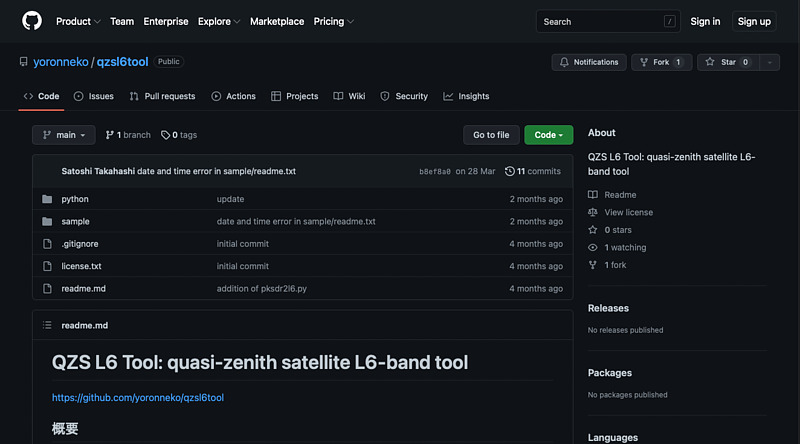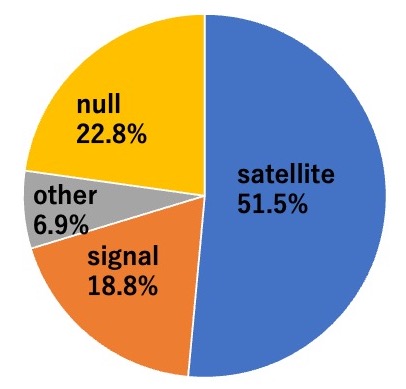Capacity analysis of CLAS satellite augmentation information using QZSS archive data
Introduction
The information contained in the centimeter-level augmentation service (CLAS) broadcast by the quasi-zenith satellite system (QZSS), petnamed Michibiki, is roughly divided into those related to satellites and those related to regions. Regarding the former, I examined the possibility of increasing the number of augmented satellites based on the number of transmission bits.
The content of the article will be presented at the research presentation of the 2022 General Conference of the Institute of Positioning, Navigation and Timing of Japan. The manuscript (in Japanese) is also published on the site.
{{ imglink href=“https://s-taka.org/xfer/202206ipntj-presen.pdf" desc=“Presentation material for IPNTJ Conference on June 2022” img=“202206ipntj-presen.jpg” >}}
Modification of QZS L6 Tool
Here, 1 hour of CLAS augmentation information from 2022-01-01 00:00:00 UTC (2022-01-01 09:00:00 Japan time) is downloaded from the QZSS archive data service.
I have modified QZS L6 Tool for this capacity analysis to include the number of satellites (Nsat), the number of signals (Nsig), and the number of augmented information bits related to the satellites (Bsat), the number of supplementary information bits related to the signal (Bsig), the number of other information bits such as header and convection delay (Bother), the number of null information (Bnull) are recorded. You can download of this modified code by checking out this 202206ipntj branch of QZS L6 Tool. The modified code is qzsl62rtcm.py only.
git clone https://github.com/yoronneko/qzsl6tool -b 202206ipntj

You can easily check this correction on GitHub.

If we set this modified code qzsl62rtcm.py to trace option level 3 -t 3, the above information will be printed with the IPNTJ header. When we execute the following command in the python directory, the CLAS information file in the sample of QZS L6 Tool will be analyzed and the number of satellites and required bits will be saved in 202206ipntj.txt.
cat ../samples/2022001A.l6 | ./qzsl62rtcm.py -t 3 | grep IPNTJ > 202206ipntj.txt
In this code, when it find a message of subtype (ST) 1, it displays the number of bits aggregated. Therefore, the first data is invalid and will be removed during aggregation. Also, since the last data will not be output, the result is forcibly output in the main routine.
It takes 30 seconds to transmit a frame (a series of augmented information blocks), and since this data is for 1 hour, 120 frames of data are output during this period. Here, this data was aggregated using Excel (202206ipntj.xlsx).
Current status of CLAS augmentation information
The CLAS message broadcast from this 2022-01-01 00:00:00 UTC in one hour is as follows.
| ST | message name | items to be augmented |
|---|---|---|
| 1 | Mask | (definition) |
| 2 | GNSS Orbit Correction | satellite |
| 3 | GNSS Clock Correction | satellite |
| 4 | GNSS Satellite Code Bias | signal |
| 6 | GNSS Satellite Code and Phase Bias | signal |
| 7 | GNSS URA | satellite |
| 11 | GNSS Combined Correction | satellite |
| 12 | Atmospheric Correction | regional, satellite |
When ST1 was decoded, the number of satellites to be augmented was 17 to 19, and the average number was 18.3. With ST12, which began broadcasting on November 30, 2020, there was an announcement that the maximum number of satellites to be augmented will be expanded from 11 to 17. Now it seems to be augmented for more satellites.
For these CLAS messages, the bit number ratios for satellite augmentation, signal augmentation, and other non-information are as follows. It can be seen that the bit occupation ratio of satellite augmentation is higher than that of signal augmentation and tropospheric delay augmentation.

The percentage of zero-padded no-information bits accounted for 22% of the total. The average of these numbers and the number of bits is summarized in the table.
| average number per period | average bit per period | |
|---|---|---|
| satellite | 18.3 | 26169.2 |
| signal | 50.6 | 9584.2 |
| other | 3509.6 | |
| null | 11587.0 | |
| total | 50850.0 |
From this table, it can be seen that as the number of satellites increases, it increases by 1340.7 bits, as the number of signals increases, it increases by 189.5 bits, and 2.8 signals are broadcast per satellite.
If the non-information margin bit is used to increase the number of satellites, it seems possible to add about 5 satellites by simple calculation. In addition, since the bit capacity depending on the number of signals is small, it is possible to augment the Galileo E5b signal, which is not currently being broadcast, in terms of line capacity.
Conclusion
I investigated the capacity of CLAS augmentation information regarding satellite augmentation. When subtype 12 was introduced, it was announced that the maximum number of satellites to be augmented would be 17, but now I have confirmed the augmentation of 17 to 19 satellites, which is more than that. In the current CLAS, the augmentation signal for Galileo’s E5b signal is not broadcast, but the E5b signal augmentation information can also be broadcast at the transmission capacity point. Regarding the number of satellites, it seems that the number of satellites to be augmented can be added a few more.
This result also depends on the satellite placement, so at least 24 hours of analysis had to be done. It was also necessary to analyze the active ionospheric activity around July. This is a topic for future study.
Related article(s):
- CLAS multi-stream test broadcast 1st July 2025
- Display of MADOCA-PPP ionospheric delay information using QZS L6 Tool 16th August 2024
- QZS L6 Tool output format change 14th April 2024
- Health information expression for QZSS 7-satellite configuration 12th April 2024
- Galileo Timing Service Message 6th April 2024
- L1S signal analysis with QZS L6 Tool 11st November 2023
- Galileo HAS live stream 25th July 2023
- HAS message display capability on QZS L6 Tool 5th March 2023
- Trial delivery of QZSS's MADOCA-PPP started 18th August 2022
- QZSS CLAS tropospheric delay augmentation information for remote islands in Japan 17th May 2022
- Compact SSR display capability on QZS L6 Tool 29th March 2022
- Release of QZS L6 Tool, a positioning satellite message display tool 3rd February 2022